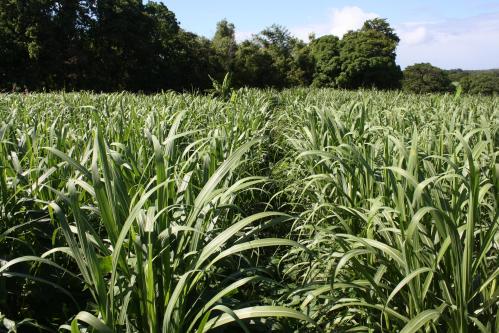
Bezard Windmill. Photo by Richard Varr
My trip last month to Guadeloupe, part of the French West Indies, took me to the archipelago’s outer island where the pace is like it was 40 years ago. At least that’s what the locals will tell you on pancake-shaped Marie Galante, only 9 miles or so in diameter.

Sugarcane fields on Marie Galante. Photo by Richard Varr
“It’s a very simple life and a very nice life, too,” says Celine Malraux, a local author whose husband owns Distillerie Bellevue, one of the island’s three rum distilleries. “Everybody has their gardens with fresh avocados, breadfruit, mangoes, with everything they need to grow. Rum is cheap, fish and lobster are cheap. At the same time, you buy fish from the hands of the fisherman.”

Rum tasting at Distillerie Bellevue. Photo by Richard Varr
Marie Galante is breezy, there’s no traffic and cows graze in verdant meadows. It’s smaller tourist draw is mostly French visitors; I heard hardly a word of English during my December visit. Palm trees cluster along the edges of sugarcane fields as far as the eye can see. In fact, sugarcane is still the basis of the economy just like it was when plantations took root in the 1600s.

Bezard Windmill. Photo by Richard Varr
Marie Galante is known as “island of 100 windmills” – a nickname that lured me to learn more about the island and its history. The name stems from when 106 windmills crushed sugarcane during the height of the plantations; now 72 remain, although mostly brick stumps and dilapidated in overgrown brush. Rusted gears are often seen scattered in and around the structures. Only two actually turn: the Bézard Windmill on a grassy hill and the other on the grounds of Distillerie Bellevue.
Marie Galante’s rum brands are rhum agricole – particularly popular in the French Caribbean and made from sweet cane juice, not molasses. Bellevue produces aged brown rum at 45 percent alcohol and clear white rums reaching 50 and 59 percent. “They’re lighter and fit into different types of drinks and go very well with citrus, lime, grapefruit or orange,” says Malraux. The island’s two other distilleries are Bielle and Poisson.

Murat Plantation Great House. Photo by Richard Varr

Windmill stump at Murat Plantation. Photo by Richard Varr
To learn more about Marie Galante’s plantation life, I stop by the Murat Plantation museum with windmill ruins, well-preserved stone walls of an old sugar factory and a restored Great House on a scenic hill. The plantation started in the mid 1600s, but the Great House wasn’t built until the early 1800s when Frenchman Dominique Murat took over the land. Murat is among 17 sites of notable slavery history as part of the Conseil Général of Guadeloupe’s “Slave Route – Traces of Memory” project that showcases monuments, forts and other locations as well.

Views of Capesterre. Photo by Richard Varr
To get to Marie Galante, I took the hour-long, high-speed ferry from Guadeloupe’s Pointe-à-Pitre. It docks in Grand-Bourg, not far from the village’s main market and central St. Marie Church. I grabbed a taxi for an afternoon well spent visiting distilleries and driving on roads that carve around the gently sloping hills topped with swaying sugarcane stalks. Other highlights not to be missed include the views overlooking the red roofs of seaside Capesterre and seemingly perfect Feuillère Beach nearby, shaded and poignantly framed by palm trees.

Feuillère Beach. Photo by Richard Varr
